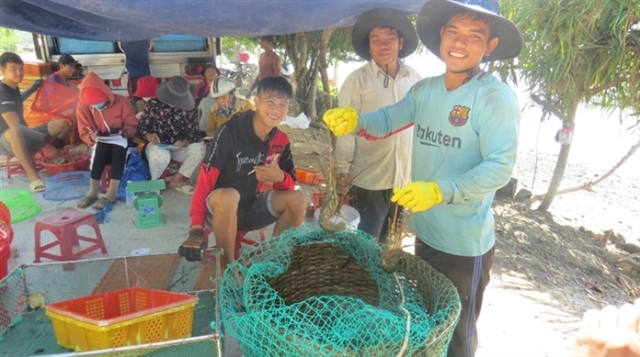 Society
Society


|
| Sông Cầu Township is now home to 55,000 lobster cages, mainly scalloped spiny lobsters, according to its People's Committee. |
PHÚ YÊN — Nguyễn Văn Trung, a resident of An Thạch Commune in Tuy An District of Phú Yên Province, has farmed shrimp for ten years.
It used to be a high-paying business, but now diseases triggered by water pollution, decreasing prices and unstable demand have put his livelihood in a precarious position.
After feeding the lobster in the Xuân Đài Bay, known as the shrimp capital of the province, Trung dived into the cages to check on them, only to find out that a few lobsters as big as his wrists could only move slowly, a sign that they had contracted diseases.
“The shrimp was clung by hàu chỉ (a type of oyster), meaning it is unable to change shell - this is a sign of sickness,” he said.
Three years ago, when Trung was about to harvest the shrimp for sale, the water changed colour due to the pollution, leading to 90 per cent of his lobsters dying.
The lobsters of various types were supposed to be sold for VNĐ1 million to 1.8 million per kg.
“I was empty-handed,” he said.
According to the Animal Husbandry and Veterinary Department of Phú Yên, black gill disease and infection caused by rickettsial-like organisms bacteria have spread widely in shrimp farms in Sông Cầu Township and affected all types of shrimps farmed here.
The department said that the main cause of this spread was the high density of cages, which affected the water flow rate and hindered the circulation of water.

|
| Shrimp farmers in Phú Yên are hit hard by falling prices. Photos nongnghiep.vn |
Aquaculture activities also contributed to water pollution, with environmental indicators exceeding the allowed threshold, it said.
Xuân Đài Bay, which stretches Xuân Đài, Xuân Thành, Xuân Yên wards and Xuân Phương Commune in Sông Cầu Township, is well known by many people as the shrimp capital of Phú Yên Province and of the whole country.
Sông Cầu Township is now home to 55,000 lobster cages, mainly scalloped spiny lobsters, according to its People's Committee.
Bùi Văn Phong, who has been in this business for 15 years, also has to scale down his business due to concerns over disease and weather conditions.
What concerns farmers here the most is sudden downpours. Lobsters don't die in freshwater, but they can go into shock, Phong said.
The first month of the rainy season is when lobsters easily fall sick, leaving local farmers worried about their health.
Decreasing prices have also hit local shrimp farmers hard.
Currently, the price of tôm hùm bông (Ornate spiny lobster) ranges from VNĐ930,000 to 950,000 a kg, tôm hùm xanh (Scalloped spiny lobster) at around VNĐ750,000 a kg.
In previous years, they could be sold for VNĐ800,000-1 million a kg for tôm hùm bông and up to VNĐ1.9 million for tôm hùm xanh.
Nguyễn Trọng Tùng, Director of Phú Yên’s Department of Agriculture and Rural Development, said the department advised shrimp farmers to check the quality of feed.
The use of fresh food as feed must ensure quality and be supplemented with probiotics, vitamins and minerals to increase resistance in changing weather conditions so that shrimp can better withstand pathogens, he said. — VNS